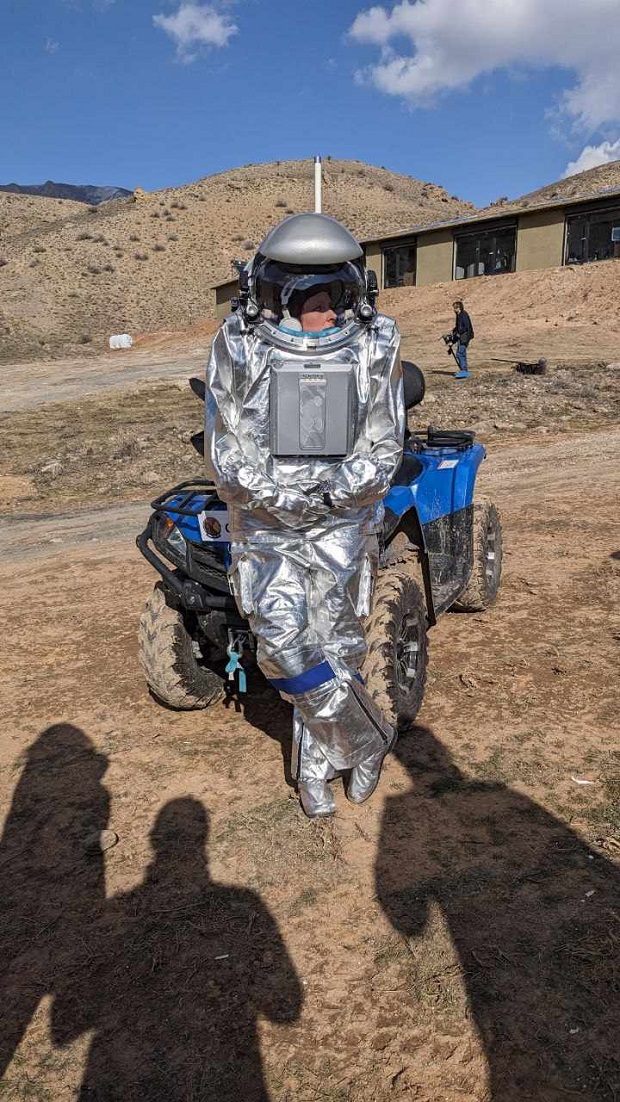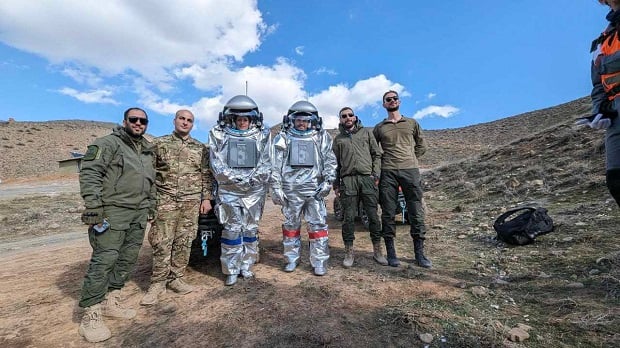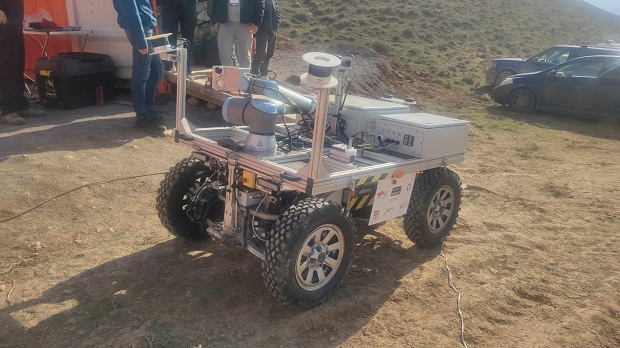What will analog astronauts do in Armenian mountains and how will their work help future missions to Mars?
Analog astronauts are unlikely to ever fly into outer space. However, here on Earth, they perform important work, the results of which will play an invaluable role in future space missions. As part of such a preparatory mission, a crew of six analog astronauts arrived in Armenia and will spend almost a month in the mountains of the Ararat region: their research will help those who, in 20 or even 10 years, will fly to conquer Mars.
Hayk Aslanyan, a member of the Armenian initiative group and head of the Armenian Space Forum, said in an interview with NEWS.am Tech that the location for the “space station”, where a crew of six analog astronauts will spend the coming weeks, was not chosen by chance: this is a rocky plateau, geologically and topographically very similar to Martian landscapes.
The mission is part of the prestigious Analog Mars Exploration Program (“AMADEE-24”). The Armenian Aerospace Agency, Armenian Space Forum and Austrian Space Forum are responsible for its implementation.
Could Armenians be among the first to set foot on Mars?
According to Aslanyan, the first human flight to Mars will happen even earlier than we can imagine: the technologies that allow us to reach the Red Planet have existed for many years, and in the near future, they will be further improved. Several well-known billionaires, including Elon Musk, are actively investing in various programs related to the exploration of Mars, and their interest will further speed up all processes and increase the chances of success.
Currently, only robots “live” on Mars, and the very first of them, which is noteworthy, was developed by the scientist of Armenian origin Alexander Kemurdzhian. Since the times of the Soviet Union, Armenians have played an important role in the development of space technology - and now they should not lag behind. Aslanyan does not exclude that Armenians may be among the first people to set foot on the surface of Mars.
“The generation that will set foot on Mars already lives next to us - they are already 10-15 years old. Perhaps even someone from Armenia will be among the future conquerors of Mars,” he said.
Mission is possible: Prepare for a flight to Mars
Anika Mehlis, the crew commander, told NEWS.am Tech that the goal of their program is to test a number of processes that will have to be carried out during the first real Mars mission. She and her team are isolated for almost a month in a space station simulator in the Armenian mountains, where they will conduct various studies (geological, biological, etc.) and experiment with Mars rovers and robotics. Communication with “Earth” will be carried out with 10-minute delays - as if they were actually on Mars. In addition, they will be able to leave the station only in special spacesuits. True, it will be possible to move around the surface not only on foot, but also on special quad bikes.
“The spacesuit simulators are very heavy - they weigh almost 50 kilograms, and for all of us this is quite a challenge. We trained a lot to be in good shape and be able to work in such suits, but if you work in it for several days in a row, then you really feel it on yourself, and then it takes time to recover,” Mehlis said.
These spacesuits are quite similar to those used in real space missions, but they do not have oxygen cylinders - the astronauts will breathe real Ararat air. It takes about 2-3 hours to put on such a spacesuit and connect everything. It takes about half an hour to remove it.

During the program, each day for analog astronauts will be regulated - just like during real missions, for example, on the International Space Station.
“In the morning we get up, have breakfast, have a briefing, then start experiments. We also go outside, always together, in simulator suits, to collect various samples for research and so on. The rest remain inside and continue their work. There will be days when we can rest a little, prepare reports, and so on,” said the crew commander.
During the program, they will not eat food from “tubes” at all, but quite “ordinary” food: its supplies will be delivered to the station in advance. Most of the food, the commander expects, will be canned or dried, but the astronauts will be able to cook something from it on site.
Because the mission is so short, the astronauts' free time will be very limited, she said. But Mehlis has some ideas about how to fill this very free time: in the past she already had to participate in a similar mission, and then she and the crew cooked food together, talked, read books and, in the end, tried to get some sleep.
According to Anika Mehlis, the main goal of this program is to find out, under simulation conditions, how to most effectively organize the work of people and robots during a real Mars mission, to understand what problems may arise and how they can be avoided or solved. In addition, the collected data will also help improve equipment and spacesuits that will be used in future missions.
“In 10-20 years, when people fly to Mars, we will follow their progress and think that that part of the spacesuit they wear was developed thanks to us!”
Opposite sides attract each other, and the truth is born in a dispute? This won't work in space!
The authors of feature films and books like to gather people with very different characters and worldviews in one crew: conflicts between them make the plot more interesting. In real space missions, such different people are unlikely to end up on the same team: special attention is paid to the compatibility of crew members, because these people will have to live and work together in dangerous, difficult conditions, and the success of the mission, and their chance of survival and homecoming depends on their mutual understanding.
Analog astronaut Iñigo Muñoz Elorza, one of the crew members of the AMADEE-24 program, told NEWS.am Tech that both real and analog astronauts undergo a strict selection process, and much attention is paid to the psychological profile of the candidates.

“We all undergo psychological tests that allow us to understand what a person is like, what kind of character he has, whether he can work under pressure, cope with stressful situations, whether he can work in a team, follow orders, take command if necessary – everything this is very important for space missions,” he said.
Missions to Mars will last about two years, or even longer, and therefore it is extremely important to assemble a team that can collaborate effectively. The AMADEE-24 program can provide some assistance in this matter: although the program participants will have to spend a little less than a month together in isolation, their experience should help develop the right approaches to selecting crew members and preparing them for long missions.
Prototype rover that will fly to Mars
Gerald Steinbauer-Wagner and his team developed a prototype rover that will explore Mars with astronauts in the future. In the meantime, analog astronauts are testing a prototype in the Armenian mountains.
Steinbauer-Wagner said that this rover can be sent to explore the area so that astronauts do not have to put on spacesuits and leave the station unless absolutely necessary: it is equipped with a robotic arm, a spectroscope, a laser, cameras and other devices that will help analyze various places of interest, soil , rocks – and even look for signs of life and water.

“It’s important to note that this is a semi-autonomous rover, and astronauts can take control of it at any time. If, for example, he went up somewhere and got stuck, the astronaut can take control, bring him to a more convenient place, and then he will continue on his way,” the scientist explained.
Rovers developed by Steinbauer-Wagner and his team have participated in all three AMADEE missions - in Oman in 2018, in Israel in 2021, and now in Armenia. The new rover, which will be tested here, has an improved configuration and a robotic “arm”, which was not present in previous versions.
True, such a rover will not be able to be sent on a real Martian mission: its hardware, as Steinbauer-Wagner noted in an interview with NEWS.am Tech, will not work on the Red Planet. So, the prototype runs on pressurized tires – and it copes well with the steep slopes of the Armenian mountains – but on Mars the rover will need tires made of a special metal alloy. Additionally, the rover will need a thermal management system to help it survive extreme cold.
- Related News
- Wheel of Death: new method will help astronauts stay fit in low gravity
- Due to anomalies of Orion spacecraft, lunar exploration program may be delayed for years։ NASA
- TAO Observatory: World's highest telescope to study evolution of galaxies and exoplanets
- Powerful M9.5 solar flare causes radio blackout in Pacific Ocean
- What will happen to the Earth if the Moon disappears?
- Key to conquering the Red Planet: Why is NASA studying solar storms on Mars?
- Most read
month
week
day
- Digital Julfa Network is launching a pan-Armenian centre in the metaverse, on the Fastexverse virtual platform 909
- Sparkles: Boston Dynamics unveils a furry robot dog that can dance (video) 793
- Xiaomi unveils exclusive Redmi Note 13 Pro+ dedicated to Messi and Argentina national team 792
- Is there a ninth planet in the solar system? Scientists find new evidence 670
- Smartphone catches fire in child's hand in Russia 655
- What will happen to the Earth if the Moon disappears? 645
- How to understand how protected a smartphone is from water and dust? 636
- World's largest 3D printer was created in USL It prints 29 meter-long structures 620
- iPhone 16 may get colored matte glass back panel, 7 colors 610
- New iPad Pro to receive M4 chip and to be more powerful than Apple computers 609
- Archive
